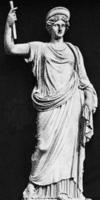- Juno
-
/jooh"noh/, n., pl. Junos for 3.1. the ancient Roman queen of heaven, a daughter of Saturn and the wife and sister of Jupiter: the protector of women and marriage. Cf. Hera.2. Astron. the fourth largest and one of the four brightest asteroids.3. a woman of regal appearance or bearing.4. Mil. the code name for a beach on France's Normandy coast, attacked by Canadian forces as part of the Allies' D-day invasion on June 6, 1944.5. a female given name.
* * *
In Roman religion, the chief goddess and female counterpart of Jupiter.She was identified with the Greek goddess Hera. With Jupiter and Minerva she was a member of the Capitoline triad of deities traditionally introduced into Rome by the Etruscans. She was connected with all aspects of the lives of women, particularly marriage. Individualized, she became a female guardian spirit; as every man had his genius, so every woman had her juno. Her temple in Rome eventually housed the Roman mint, and she was invoked as the savior of the state. Her sacred bird was the peacock. Juno, classical sculpture; in the Museo Archeologico Nazionale, NaplesAlinari-Art Resource
Juno, classical sculpture; in the Museo Archeologico Nazionale, NaplesAlinari-Art Resource* * *
▪ Roman goddessin Roman religion, chief goddess and female counterpart of Jupiter, closely resembling the Greek Hera, with whom she was identified. With Jupiter and Minerva, she was a member of the Capitoline triad of deities traditionally introduced by the Etruscan kings. Juno was connected with all aspects of the life of women, most particularly married life. Ovid (Fasti, Book V) relates that Juno was jealous of Jupiter for giving birth to Minerva from his own head. After Flora gave her an herb, Juno gave birth to Mars.As Juno Lucina, goddess of childbirth, she had a temple on the Esquiline from the 4th century BC. In her role as female comforter she assumed various descriptive names. Individualized, she became a female guardian angel; as every man had his genius, so every woman had her juno. Thus, she represented, in a sense, the female principle of life.As her cult expanded she assumed wider functions and became, like Hera, the principal female divinity of the state. For example, as Sospita, portrayed as an armed deity, she was invoked all over Latium and particularly at Lanuvium, originally as a saviour of women but eventually as saviour of the state. As Juno Moneta (“the Warner”), she had a temple on the Arx (the northern summit of the Capitoline Hill) from 344 BC; it later housed the Roman mint, and the words “mint” and “money” derive from the name. According to Plutarch, the cackling of her sacred geese saved the Arx from the Gauls in 390 BC. Her significant festivals were the Matronalia on March 1 and the Nonae Caprotinae, which was celebrated under a wild fig tree in the Campus Martius on July 7. Juno is represented in various guises. Most frequently, however, she is portrayed as a standing matron of statuesque proportions and severe beauty, occasionally exhibiting military characteristics.* * *
Universalium. 2010.
